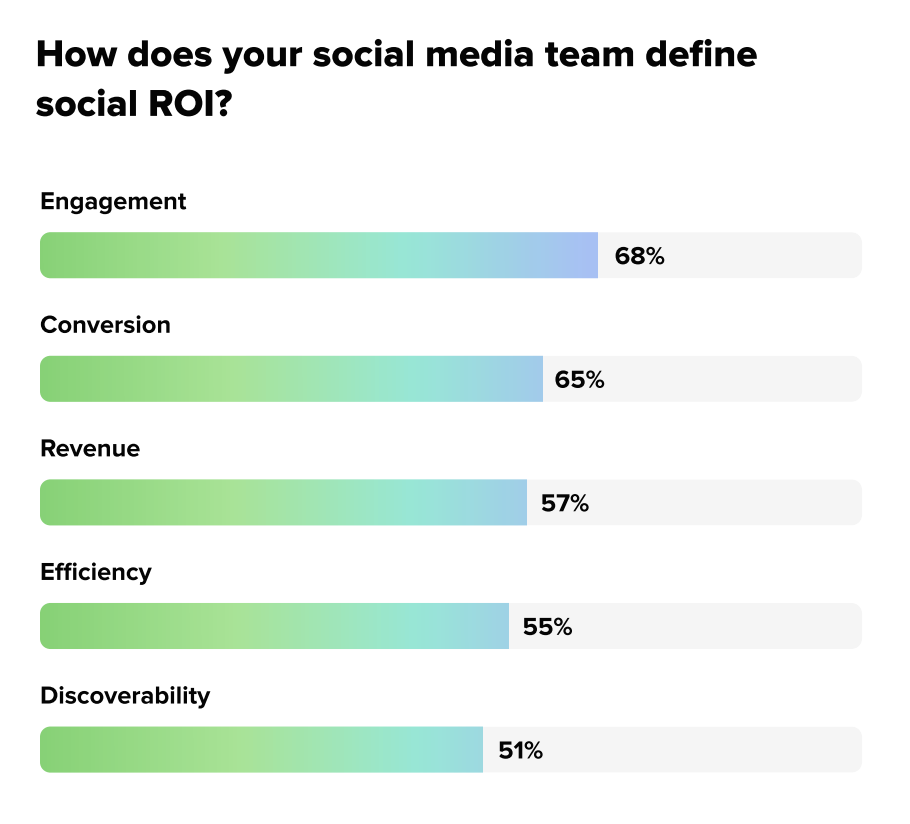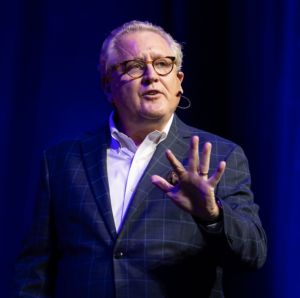
I’ve been immersed in the world of social media marketing since the beginning. It was so exciting to be part of those early pioneering days!
It took us years to determine how authentic creativity and real human engagement blended (or didn’t blend) with the stodgy culture of traditional corporate marketing.
It took a lot of patience and experimentation to prove that we fit a marketing department. The biggest question we always faced: “How do you measure the value of this stuff?”
I lost one of my first customers because I couldn’t measure the ROI of a tweet!
We’ve come a long way, and social media marketing has evolved into an independent skill set and budget item. However, according to new research from Sprout Social, we’ve made little progress in terms of measurement and legitimizing our work.
This chart from the report made my head spin:

So 68% of social media marketers define Return on Investment … by engagement???
No wonder some regard the field as fluffy.
ROI is a financial measurement. Period. Always has been. Always will be.
If you came to my office justifying the ROI of your effort by engagement, I’d throw you out.
Social media marketers have been at this for more than a decade. Shouldn’t we be aligned with the real language of business by now?
To make matters worse, there is little to no correlation between engagement and the business’s revenue, conversions, or brand loyalty. Social media marketers are literally picking the worst possible measurement — engagement — to justify their existence.
The purpose of marketing is to create customers. If you’re driving engagement without conversions, you’re “engaging” your company into the poor house. Let’s look at a better way.
What “Measurable ROI” Looks Like
When we say “social media,” do we mean ads or Instagram Reels? Sprout probably needs to do a little better with the question because a good marketer will use both, and “ROI” lands in different ways.
 When we consider social media advertising, we can generally measure ROI with precision — Conversions, CPA, ROAS.
When we consider social media advertising, we can generally measure ROI with precision — Conversions, CPA, ROAS.
When you run paid campaigns with clear calls to action, you can measure cost per acquisition, return on ad spend, and lead generation. This is where social media behaves like any other performance channel.
So for the “bottom of funnel” or “middle to bottom funnel” activity, social media is highly measurable. You can put in dollars, get out hard numbers, rinse and repeat.
This success requires collaboration with a trusted, experienced ad partner, but on the performance marketing side of the business, the real ROI of social media is easily measured. So why not say so?
Brand Marketing is Critical, Too
Now to the less measurable, but equally crucial side: awareness, trust, brand equity. This represents brand marketing, and these benefits matter deeply, but they don’t always show up on the next quarter’s P&L in obvious ways.
Direct ROI attribution for organic TikTok videos, thought leadership posts, and podcasts is notoriously difficult.
My friend Martin O’Leary put it well in his excellent newsletter:
- 77.5% of sharing is invisible (Dark Social data)
- 93% of attribution died with iOS 14.5 (Dashboard data)
- Most metrics don’t drive revenue anyway (Vanity metrics data)
If you’re obsessed with attribution and engagement, you’re not seeing the full picture. And that might be the best thing that’s happened to you.
Because once obsession over attribution dies, you have to look elsewhere.
- Do people remember you?
- Are they talking about you?
- Do they come back without needing a discount code?
That’s marketing.
Not math.
This is where we usually fumble the ROI discussion. It’s hard to find the money, so we revert to “engagement” because it’s easy to measure.
But not all measurements are important. And, in this case, all things important cannot be easily measured.
Brand marketing — and I would include almost all organic posting in this category — is essential because it builds a company’s emotional connection with its audience, fosters long-term trust, and ultimately drives sustainable growth. In a world flooded with noise, choice, and copycats, a brand is the one thing nobody else can replicate. It’s your reputation, your signal, and your promise all wrapped into one.
The Brand Equity Imperative
Your reputation and brand equity is hard to quantify on a month-to-month basis, especially for smaller companies, but it is no less important than the advertising side. Done right, social media can propel awareness, foster brand conversations, and cultivate a community that can significantly increase revenue.
Brand equity is a proxy for trust. People don’t buy from faceless companies. They buy from those they feel understand them. And trust is earned through consistent, human-centered communication. When your marketing focuses on reinforcing your values and emotional resonance, it accelerates the building of trust.
Second, brand marketing creates differentiation. In fact, it is probably your only differentiation. Competing on features or price is a race to the bottom. The best brands compete on emotion, identity, and belonging. Apple, Patagonia, and Nike aren’t just companies. They’re symbols of aspiration and identity.
Third, a well-developed brand becomes a growth engine. Studies show that brand-loyal customers spend more, refer more, and forgive more. They become your marketing department (see my book Marketing Rebellion to do a deep dive on that idea).
Brand marketing builds resilience. When economic conditions shift or new competitors enter the market, it’s not just your product that keeps you afloat — it’s your brand equity. A well-loved brand gives you margin, customer loyalty, and relevance when everything else is uncertain.
Finally, brand marketing has a compounding effect. The more people encounter your message in a clear, emotional, and consistent way, the more brand momentum you build. Like investing, the returns grow over time.
Measuring Social Media Brand Marketing
Just because social media brand marketing is harder to measure doesn’t mean it’s unmeasurable. But folks, we need to move beyond engagement.
The truth is, there are reliable indicators that show how your brand-building efforts contribute to ROI over time. These may not appear to be instant sales, but they are leading indicators of future financial health.
Here are a few:
Share of Search
This is one of the best proxies for brand awareness. If more people are typing your brand name into Google compared to competitors, you’re winning mindshare. Les Binet’s famous research shows that share of search is a strong predictor of future market share.
Branded Traffic
Website visits that come directly from brand-related keywords and links are another sign of brand equity. Growth in branded search volume indicates that customers know you, remember you, and are actively seeking you out.
A side comment — When customers care enough about you to include your name in a search, you are “overriding” the automated decision-making of AI. In the AI world, brand is more important than ever.
Customer Lifetime Value (CLV)
A strong brand doesn’t just attract customers; it keeps them. CLV grows when your brand fosters loyalty and repeat purchase behavior.
Referral Rates and NPS (Net Promoter Score)
People are more likely to recommend brands they trust. Tracking referrals, reviews, and NPS is a way to connect emotional equity to bottom-line growth.
First-Party Data > Everything
If you don’t own the relationship, you don’t own the result. Attribution models that rely on third-party data are dead. What works now:
- Email capture with progressive profiling
- Customer accounts with behavioral tracking
- Direct website visits through branded searches
- SMS opt-ins for immediate communication
Pricing Power
Strong brands can command a premium price. If you can maintain margins or raise prices without losing customers, that’s a measurable ROI of brand strength.
Subscriptions
Especially for small businesses, building an email list is everything. These are the people who love you and will buy from you. Subscribers are a leading indicator to revenue.
It’s hard to attribute brand marketing to a precise dollar amount on every social media post, but you can measure whether your social media efforts are moving the levers that ultimately lead to revenue and customer acquisition.
So yes, social media is both advertising (measurable today) and brand marketing (measurable over time). Budget for both brand AND performance marketing. When you account for both sides of the equation, you’re not just justifying social media — you’re proving its role as a powerful business driver.
Just don’t ruin it by telling your boss that an increase in engagement is the ROI of your marketing! Are you with me on this?
 Need a keynote speaker? Mark Schaefer is the most trusted voice in marketing. Your conference guests will buzz about his insights long after your event! Mark is the author of some of the world’s bestselling marketing books, a college educator, and an advisor to many of the world’s largest brands. Contact Mark to have him bring a fun, meaningful, and memorable presentation to your company event or conference.
Need a keynote speaker? Mark Schaefer is the most trusted voice in marketing. Your conference guests will buzz about his insights long after your event! Mark is the author of some of the world’s bestselling marketing books, a college educator, and an advisor to many of the world’s largest brands. Contact Mark to have him bring a fun, meaningful, and memorable presentation to your company event or conference.


